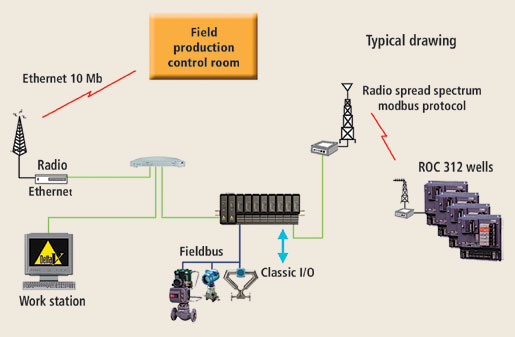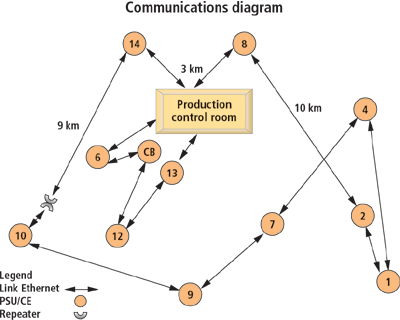Wireless Ethernet integrates gas field automation
Automation & ControlWireless Ethernet integrates gas field automationHow Repsol-YPF integrated a major gas field in Argentina to include field, plant and buildings into a single automation system.Luis Troncoso and Diego Arevalo, Repsol-YPF; and Nestor C. Artusi, Chromu S.A./ Emerson Process Management How do you automate a natural gas field that is roughly 28-mi square to operate as if it were a single plant covering just a few acres? This was the question faced by Repsol-YPF engineers in a project to modernize control of the company's Loma La Lata gas field. The field is vital to Argentina's economy. Its capacity of 1.413 Bcfd of gas and 84,760 cfd of gas liquids represents 30% of the country's output. Scattered across the field's 768 sq mi are about 200 wells, of which 74 are tied to a SCADA system. There are also 14 primary separation units, a main gas processing plant, a smaller gas plant (including an amine production facility), a field production office and a maintenance facility. Integrating the field, plants and buildings into a single automation system was a challenge because of the need to establish sophisticated, fast and secure control communications across a difficult terrain of hills and lakes. The new automation also had to meet ISO 14000 environmental standards, as well as the company's quality and safety standards, without interfering with the indigenous population. It was obvious from the start that the automation's lifetime cost of ownership was substantially more important than its installed cost, i.e., the engineers realized that they had to assure the highest possible control reliability, versatility and minimum long-term labor input. This would be accomplished by remoting, as much as possible, the control hardware and logic while at the same time optimizing configuration, calibration, diagnostics, maintenance and asset management from a central location. DIGITAL AUTOMATION To achieve these goals in phases over several years, Repsol-YPF elected to replace Loma La Lata's existing DCS and PLC controls, and less capable communications, with a scalable, digital automation platform featuring versatile Ethernet communications. It was also specified that the new system should provide the flexibility to right-size the initial installation, then scale up without needing to re-engineer or replace existing control elements or to call upon additional platforms. Advanced PlantWeb* field-based digital automation from Emerson Process Management encouraged Repsol-YPF engineers to field-distribute powerful DeltaV* controllers near the equipment being controlled. Line-of-sight, TCP/IP, wireless Ethernet communications incorporated multipath redundancy. This could then efficiently and reliably integrate the sites scattered around the gas field. Such architecture would be superior to the conventional DCS approach of either running field wiring all the way back to an air conditioned control room or using relatively limited RTUs (remote terminal units), slow serial communications, and radios to connect the field to the control room. PlantWeb communications between DeltaV (digital) controllers in the field and digital PC workstations in the central control room travel via 10/100 MHz IEEE 802.3 Ethernet. They are readily amenable to copper, fiber optic and wireless, dish-antenna transmission using off-the-shelf technologies. COMPRESSOR CONTROL TACKLED FIRST The decision to upgrade control of Loma La Lata gas field was hastened by naturally declining well pressures that necessitated adding a gas compressor station at each of the field's 14 primary separation units (PSUs). The automation/ integration project was largely completed by the end of 2003 and was accomplished in two states, as follows. Phase 1 began in April 2001. An existing SCADA system was modified to include digital controllers and their powerful, operating intelligence to run the new compressor stations and touch-screen HMI panels. Phase 1 also installed digital technology to run the two processing plants, and to improve communications between the plants and nearby buildings housing the field production and maintenance offices. Phase 2 began in June 2002. Addition of FOUNDATION* fieldbus at the PSU/compressor sites was followed by integration of these sites with field production via wireless Ethernet. The SCADA communications and remote site controls in place at the end of Phase 1 in 2002 are detailed in Fig. 1, A/B. Included in the Phase 1 construction at each compressor station was addition of a redundant set of digital controllers hardwired to 56 I/O points per compressor, plus the HMI panel. The DeltaV controller provides computing power, versatility, memory and communications capabilities that surpass advanced DCS technology for less cost.
To simplify communications between each new compressor controller and field production during Phase 1, the controller was slaved to an existing Emerson Model 364 ROC remote operating controller temporarily retained to run separation activities. The digital controller was linked to the ROC, and to the compressor HMI, using a hard-wired, 9,600-bps Modbus RS-485. The ROC communicated with field production via spread-spectrum FM radio at 9,600 bps using the ROC protocol. Phase 1 also saw the new, improved automation again replacing control equipment at the main gas plant with the installation of three redundant sets of DeltaV (digital) controllers wired to existing plant I/O, four digital PC operator workstations, and one digital PC application station. Two controllers were assigned to plant process control functions, the third to plant security. The processes were previously controlled by a DCS, while safety was handled by a PLC. The application workstation was placed on the Repsol-YPF intranet to provide superior management access to real time trend, and historic data. The smaller gas/amine plant was similarly modernized with two redundant sets of digital process controllers, one redundant set of security controllers, and three operator workstations. A digital workstation was added in Maintenance for configuration interface to an AMS (Asset Management Solutions) program. All in-plant DeltaV communications, and fiber optic communications between plants and buildings, became the first elements of the Loma La Lata's single, 10 MHz DeltaV Ethernet LAN (Local Area Network). The 250-tag AMS contains a database of smart instruments and an audit trail capability for critical instruments. It is used as well for remote calibration of control valves and instrument diagnostics. The AMS will be scaled up to 750 tags to include all of the field's smart instruments. SECOND PHASE ADDS FIELDBUS, WIRELESS LAN Phase 2 began in 2002 by removing the ROC 364 unit and RS-485 communications at the PSU/compressor sites and transferring all control functions to the digital controllers, Fig. 2. At the same time, both PSU and compressor monitoring and control were upgraded through addition of 20 FOUNDATION fieldbus H1 segments and 90 fieldbus instruments.
The fieldbus devices replaced or supplemented existing classic and Hart I/O to relay more and better data back to field operations. The bus-type devices also enhance configuration, calibration, diagnostics, maintenance and asset management from the central control room. If desired in the future, some control logic can be distributed to the fieldbus devices. The wells have been long operated by Emerson Model 312 ROC units, and these controllers remain in place as do spread-spectrum, Modbus protocol, 9,600 bps FM radio communications from wells to their PSU/compressor sites. However, signals from the wells now feed into a Modbus serial card in the digital controller. Today, all Loma La Lata data communications above the controller level, including the compressor HMIs, are on Ethernet. The compressor HMI panels were converted to DeltaV PC workstations, and they now interface with the separation units as well. All long-distance Ethernet communications are wireless. Last, the entire network has been integrated with the plants and buildings onto a giant DeltaV LAN that permits full and fast access from any of the new automation's operating and application workstations. VITAL WIRELESS SITE SURVEYS AND ADJUSTMENTS The gas field's long-distance transmissions rely on small wireless bridges (BR350 Direct Sequence Ethernet Bridge, Cisco Systems Inc.) line-of-sight dish-type antennas, and standard Ethernet SNMP wireless protocol. Practical data rates of 1 to 11 Mbps can be chosen, with coverage reportedly up to 18 mi at the slowest rate. The field's longest leg is about 6.2 mi (10 km). The faster the transmission rate, the shorter the reach and the more interference possible. After configuration, the bridges were connected to standard Ethernet hubs. Once communicating, the radio frequency for each of the system's many antenna-to-antenna links was adjusted for best performance, defined as the fewest retries after interference errors. The bridge's diagnostics monitored radio statistics for the number of retries, maximum retries per frame and excessive retries. A low incidence of retries is desired to assure DeltaV communication integrity. Each proposed system leg required a site survey to find the best antenna location and operating frequency. Fig. 3 is a simplified routing map of the wireless legs eventually chosen to provide the highest integrity.
BRIDGES ACT AS REPEATERS, ROUTE MASTERS Note also in Fig. 3 that the bridges serve as repeaters, moving data across a series of legs from PSU site to site, to finally reach the Field Production Office. Note also that each PSU site terminates two to three Ethernet segments, while Field Production terminates four segments. Should a communications failure occur on any particular segment, the message normally moving over that leg will be automatically rerouted over another leg or legs. Multipath routing assures a high degree of reliability. Repsol-YPF realizes that the wireless Ethernet system is not foolproof, even with multiple paths. Communications can be – and are – lost from time to time because of interference. This is a major reason why the new automation's intelligence was distributed to controllers at the PSU/compressor sites, and also why fieldbus instruments were chosen. The automation is designed so that critical data, intelligence and control are local. The bridges are store-and-forward devices, collecting messages in buffers and placing them in a queue before transmitting. With no interference present, transmission delay is about 5 mS at 2 Mbps. No Queue Full errors have been found under normal operating conditions, indicating adequate space is available to handle the DeltaV communications load. Typical system responses seen across the integrated DeltaV Ethernet LAN are:
Further, main link wireless Ethernet data transfer is <10 mS; alternative link wireless Ethernet data transfer is <16 mS; and total shutdown of all facilities is only 20 sec from any workstation. THE FUTURE LOOKS BRIGHT Treating an oil field as an integrated plant is a relatively new concept that is proving to reduce production losses and minimize operating/ maintenance costs. Diagnostics utilities and maintenance tools for smart instruments, plus asset management software for tracking the condition and performance of instruments and equipment such as compressors are especially helpful in maintenance. Field-wide automation integration is also boosting safety and property protection because real-time process information is available across all nodes, speeding shutdowns through more comprehensive coordination and management. It additionally helps protect the environment because of more accurate control, better field data and faster corrective action. The success of field-wide integration at Loma La Lata had convinced Repsol-YPF to extend the concept. The company is presently installing a DeltaV-automated head pump station. In the near future, two more automated PSUs, plus three automated water and oil treatment plants, will be added.
|
||||||||||||||||||||||||||
- What's new in production (February 2024)
- U.S. operators reduce activity as crude prices plunge (February 2024)
- U.S. producing gas wells increase despite low prices (February 2024)
- U.S. oil and natural gas production hits record highs (February 2024)
- Dallas Fed: E&P activity essentially unchanged; optimism wanes as uncertainty jumps (January 2024)
- Enhancing preparedness: The critical role of well control system surveys (December 2023)








